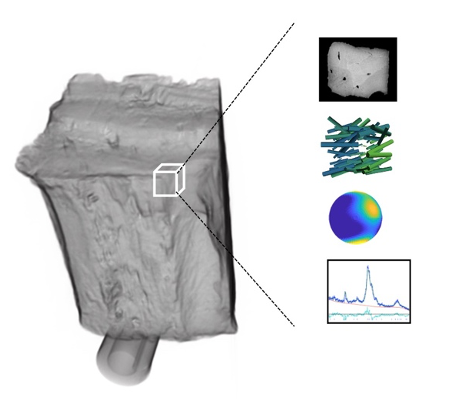Principal investigator: Tilman Grünewald
Biological materials exhibit outstanding mechanical properties and combine seemingly contradictory properties like strength and toughness together with intricate structural responses during growth and healing [1]. This is achieved by the intricate, hierarchical organization of biomaterials on the nanostructural and crystal structural level [2], the so-called crystallographic texture. The determination of the crystallographic texture and the local nanostructure in biomaterials in 3D while retaining a large field of view is an unsolved problem until now.
This problem is going to be solved by introducing texture tomography, a 3D imaging technique based on X-ray diffraction and will be employed at synchrotron radiation sources. Texture tomography allows to obtain at the same time the absorption contrast, the nanostructural orientation, the crystallographic texture and crystalline properties, as presented schematically in the figure below.

Together with collaborators at the Institute des Sciences du Mouvement, Marseille, this technique will be used to establish the connection between hierarchical organization and the mechanical behaviour of the enthesis, the biological interface between bone and tendon.
[1] 3D nanoscale analysis of bone healing around degrading Mg implants evaluated by X-ray scattering tensor tomography. M. Liebi, V. Lutz-Bueno, M. Guizar-Sicairos, B.M. Schönbauer, J. Eichler, E. Martinelli, J.F. Löffler, A. Weinberg, H. Lichtenegger and T.A. Grünewald, Acta Biomaterialia, vol 134, p.804-817, 2021 - 10.1016/j.actbio.2021.07.060
[2] Mapping the 3D orientation of nanocrystals and nanostructures in human bone: Indications of novel structural. T.A. Grünewald, M. Liebi, N.K. Wittig, A. Johannes, T. Sikjaer, L. Rejnmark, Z. Gao, M. Rosenthal, M. Guizar-Sicairos, H. Birkedal and M. Burghammer. Science Advances, vol 6, eaba4171-1-eaba4171-7, 2020 - 10.1126/sciadv.aba4171


 ResearchGate
ResearchGate Flux RSS
Flux RSS